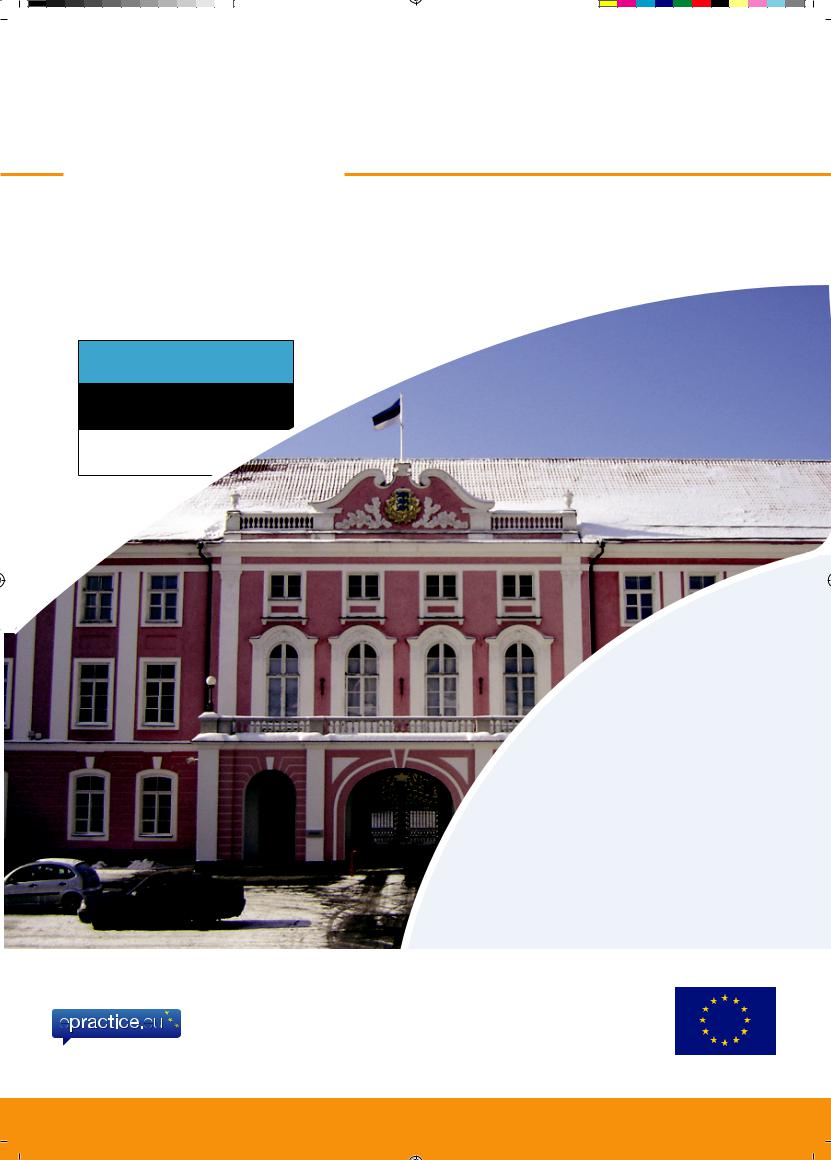
Docd7a7
.pdf
[ eGovernment in ]
Estonia
Eesti
eGovernment eGovernment
eGovernment eGovernment eGovernment
eGovernment Factsheets
November 2009
Edition 12.0
Country Profile
Strategy
Legal Framework
HistoryInside
Actors
Infrastructure
Services for Citizens
Services for Businesses
Who’s WhoWhat’s
European Commission
http://epractice.eu

[ eGovernment Factsheets - Estonia ]
Contents: |
|
CountryProfile.......................................................................... |
1 |
eGovernmentHistory................................................................. |
3 |
eGovernment Strategy............................................................. |
10 |
eGovernment Legal Framework............................................... |
15 |
eGovernmentActors................................................................ |
18 |
eGovernment Who’s Who........................................................ |
21 |
eGovernment Infrastructure..................................................... |
23 |
eGovernment Services for Citizens........................................... |
28 |
eGovernment Services for Businesses....................................... |
34 |
Disclaimer:
This document is not intended to be exhaustive. Its purpose is to give an overview of the general eGovernment situation in Estonia. Even though every care has been taken to ensure accuracy, the information herein should be treated as indicative and no responsibility for errors can be taken. Neither the European Commission, nor any person acting on its behalf is responsible for the use that could be made of the information provided.
© European Communities 2009

|
|
|
|
|
|
|
|
|
|
|
|
|
|
|
|
|
|
|
|
|
|
|
|
|
|
|
|
|
[ eGovernment in Estonia ] |
|
November 2009 |
|
|
|
|
|
|
||||||||||||||
|
|
|
|
|
|
|
|
|
|
||||||||||||||||
Country Profile
Basic data and indicators
Basic Data.........................................................................................................
Population (1 000): 1 340.415 inhabitants (2009)
GDP at market prices: 16 073 million Euros (2008)
GDP per inhabitant in PPS (Purchasing Power Standards, EU-27 = 100): 68.2 (2008)
GDP growth rate: -3.6 % (2008)
Inflation rate: 10.6 % (2008)
Unemployment rate: 5.5 % (2008)
Government debt/GDP: 4.6 % (2008)
Public balance (government deficit or surplus/GDP): -2.7 % (2008)
Source: Eurostat
Area: 45 000 km2
Capital city: Tallinn
Official EU Language: Estonian
Currency: Estonian kroon
Source: Europa Website
Political Structure................................
Estonia is a parliamentary republic.
Legislative power lies within the unicameral Parliament, called the State Assembly (Riigikogu in Estonian). The Assembly has 101 members, elected by popular vote, to serve four-year terms. Members are elected on the basis of a proportional system, and a 5 % splinter party threshold applies for those wishing to take part in parliamentary activities.
Estonia’s Head of State is the President, elected for a five-year term by the Riigikogu. The Government, exercising executive power, is formed by the Prime Minister, nominated by the president, and a total of 14
ministers. The Government is appointed by the President with the approval of the Parliament.
Estonia is divided into 15 counties and 227 urban and rural municipalities (towns and parishes), whose powers and responsibilities are established by the Local Government Organisation Act of June 1993. The Government of each county is led by a County Governor, who represents the national Government at regional level and is appointed by the Central Government for a term of five years. Local selfgovernment is exercised solely at the municipal level.
The Constitution of the Republic of Estonia was adopted on 28 June 1992.
[1]

November 2009
Estonia became a member of the European Union on 1 May 2004.
Head of State: President Toomas Hendrik Ilves (since 9 October 2006)
[ eGovernment in Estonia ]
Head of Government: Prime Minister Andrus Ansip (since 12 April 2005)
Information Society Indicators............................................................................
Percentage of households with Internet access: 58 % (2008)
Percentage of enterprises with Internet access: 96 % (2008)
Percentage of individuals using the Internet at least once a week: 62 % (2008)
Percentage of households with a broadband connection: 54 % (2008)
Percentage of enterprises with a broadband connection: 88 % (2008)
Percentage of individuals having purchased/ordered online in the last three months: 7 % (2008)
Percentage of enterprises having received orders online within the previous year: 11 % (2008)
Percentage of individuals using the Internet for interacting with public authorities: obtaining information 33 %, downloading forms 24.2 %, returning filled forms 24.4 % (2008)
Percentage of enterprises using the Internet for interacting with public authorities: obtaining information 75 %, downloading forms 75 %, returning filled forms 62 % (2008)
Source: Eurostat
Editorial notice:
Statistical indicators referenced in this section reflect those of Eurostat at the time the Edition is being prepared.
[2]

|
|
|
|
|
|
|
|
|
|
|
|
|
|
|
|
|
|
|
|
|
|
|
|
|
|
|
|
|
[ eGovernment in Estonia ] |
|
November 2009 |
|
|
|
|
|
|
||||||||||||||
|
|
|
|
|
|
|
|
|
|
||||||||||||||||
eGovernment History
Main developments and key milestones (in reverse chronological order)
For the latest developments, see: ePractice news for eGovernment
Recent News
November 2009..................................
The first information society training course is organised for the highest policy-makers in public sector institutions in order to increase their understanding of the challenges and the essence of the information society. The two-days training course organised by the Ministry of Economic Affairs and Communications and the Estonian Informatics Centre will take place regularly.
October 2009.....................................
eVoting is used again for the local government elections. The number of e-voters has been on gradual increase since 2007, when Internet-based voting was first applied in Estonia. This time, the share of e-voters among all voters reached the 15 % (over 100 000 Estonians that preferred electronic voting to the traditional method).
On 1 October 2009, the Estonian Informatics Centre - EIC (Riigi Infosüsteemide Arenduskeskus - RIA) opens its Department for Critical Information Infrastructure Protection (CIIP). CIIP aims to create the defence system for Estonia's critical information infrastructure and to run this system. The new Department will deal with the protection of important IT systems of the public and private sectors alike. CIIP will coordinate the general protective actions while the owners of each vital service concerned will remain responsible for the daily defence of their system.
The Estonian Government's Informatics Centre (RIA) publishes two more versions of its open source software to enable the users of Mac OS X and GNU/Linux to have an access to their electronic identity card functionalities. The software
development was supported by the EU Regional Development Fund and the application was developed by an Estonian IT company. The e-ID card application is published under the LGPLv2.
August 2009.......................................
Estonia’s largest ICT companies established the Estonian Broadband Development Foundation the objective of which is to develop, by the end of 2015, a basic infrastructure of the new generation broadband network in Estonian rural areas.
An ambitious initiative called Estonian IT Academy is launched in cooperation between the Estonian Development Fund, the Association of Information Technology and Telecommunications Companies and Estonian universities. The objective of the joint initiative is to increase the quality of Estonia’s higher education in the field of ICT so that it would be capable of international breakthrough
July 2009..........................................
The Government of the Republic approved the amended version of the ’Estonian Information Society Strategy 2007-2013’. The update concerns measure 4.1.1, ’Broadening technological access to digital information’ to which a chapter was added on the development of broadband internet. In addition, the Estonian ‘Rural Development Plan 2007-2013’ was amended in summer 2009 in order to allow for the use of resources of the EU recovery package.
June 2009.........................................
eVoting is used in the framework of European Parliament elections. With the national ID card, eVoting will be used between 28 May-3 June 2009.
[3]

November 2009
Internet-based voting will also be used in Estonia during the local government elections in fall 2009.
May 2009...........................................
During the second week of May 2009, the first company in Estonian business history is created in the Company Registration Portal with a Finnish ID card, without the founders of the company having had to leave their desks to get the company officially registered in Estonia. According to Ingmar Vali, the head of the Court Registry Department at the Centre of Registers and Information Systems, the Estonian Company Registration Portal was opened to the users of Finnish ID-cards at the end of last year. The portal also accepts digital signatures from Portugal, Belgium and Lithuania. The newly-created company has two Estonian and three Finnish founders who all used the ID-card of their respective country in creating the company that is located in Tallinn and deals with the wholesale of electronic and telecommunications appliances and their parts.
The Estonian Government approves the
Implementation Plan 2009-2011 of the Estonian Cyber Security Strategy. The implementation supports the achievement of goals established in the Estonian Cyber Security Strategy by setting out concrete and measurable actions in five priority areas: protection of critical information infrastructure and establishment of relevant national system; increasing competence in cyber security; formation of legal framework for ensuring cyber security; bolstering international cooperation; raising awareness on cyber security.
April 2009..........................................
On 29 April 2009 the EU ministerial conference in Estonia initialized ‘Tallinn process’ in order to secure critical information infrastructure. The EU ministerial conference CIIP (Critical Information Infrastructure Protection) 2009 that took place in Tallin and focused on cyber security in Estonia, initialized the so-called "Tallinn process" and agreed to organize a joint exercise in order to
[4]
[ eGovernment in Estonia ]
upraise EU member states capabilities to protect their critical information infrastructure. The exercise will be staged by 2010, in line with the European Commission's action plan. This joint endeavor would be the first tangible achievement leading towards a strong coordination and cooperation among member states as well as a steo ahead in order to identify areas requiring immediate actions.
Launch of the “Come Along!” (Ole Kaasas!) project. This is an Internet-promotion project launched by the Look@World Foundation in the framework of the My Estonia initiative. The project aims to provide basic and advanced computer training to 100,000 people and connect 50,000 more families to the Internet over the next three years.
February 2009....................................
Estonian Internet Foundation is being established. The objectives of the organisation are the registration of the domain names and the representation of the Estonian internet community at the international level.
October 2009.....................................
An eState Charter is completed after the initiative of the National Audit Office in co-operation with experts and opinion leaders from universities, nongovernmental organisations, media and ministries among others. The document enlists and describes ten good administrative rules that should be taken into account in the provision of public eServices. The National Audit Office intends to use the principles and evaluation criteria set out in the eState Charter in its future audits assessing the quality of public services. It is also planned to launch the recognition of public services where the principles of the charter are applied. To this end, a quality mark „Wow, great eservice!“ will be awarded.

[ eGovernment in Estonia ]
News 2001-2008
2008..................................................
In September 2008 the ‘Health Services Organisation Act and Associated Acts Amendment Act’ came into force. The Act aims to unify all information systems created for the needs of specific health care organisations into one central Health Information System. This enactment thus gives the green light to the launch of four main eHealth projects, namely: Electronic Health Record (HER), Digital Image, Digital Registration and Digital Prescription. The gradual digitisation of medical documents will continue until 2013 – the official deadline for the implementation of eHealth in Estonia.
During the same month the Computer Emergency Response Team (CERT) Estonia launched a campaign named “AssaPauk”, aimed at educating ordinary computer users in Estonia. The campaign, which guides people on how to use the Internet safely, is focused on three lessons: which links are safe to click and which are not; what kind of passwords to use; how to avoid an unpleasant identity theft. Actors telling real stories are used to get the lessons across. The campaign’s webpage is www.assapauk.ee. Relevant stories are also in YouTube (in Estonian).
In August 2008 entrepreneurs were invited to activate their email address on the eGovernment Portal (www.eesti.ee) to avoid company identity theft and detect it when it occurs. Businesses which subscribe to the service will receive an automatic
November 2009
notification when the Commercial Register receives an application for altering an entry.
The eID card awareness campaign ended on 30 June 2008. Over 11 000 people participated in this record attempt.
In the same month the Estonian Government invited ideas and proposals from citizens on the improvement of eServices. Ideas can be submitted through www.osale.ee, the State website which also allows citizens to participate in the legislative procedure. Because of the high level of international interest in the Estonian eGovernment experience, a freeware platform has been created which could also be used outside of Estonia. The development of the freeware product was funded by the European Union.
In May 2008, in a bid to promote the wide-scale take-up of the eSignature in Estonia, the Estonian Informatics Centre (RIA) launched a national eID awareness campaign on 22 May 2008. The aim was to encourage anyone who has yet to use the eSignature facility on their eID card to take their first steps towards the use of secure eServices and digital signing. As part of the information campaign, RIA targeted to establish a new world record – the most digital signatures to a single document.
During the same month the Estonian Government adopted a Cyber Security Strategy. Cyber security in Estonia is primarily based on reducing the vulnerability of the cyberspace in the nation as a whole. This is accomplished through the implementation of domestic action plans, but also through an active international cooperation which supports the enhancement of cyber security in other nations as well. The vulnerability of the cyberspace is a serious asymmetrical security risk which affects all nations. It must therefore be confronted on a global level.
On 3 May 2008, Estonians have joined forces in an effort to clean up the 45 227 km² country from illegally dumped or littered waste. Technology meets volunteerism with the Estonian civic initiative, “Teeme Ära 2008!”. Approximately 11 000 waste dumping sites have been mapped by a special software. The team uses the combination
[5]

November 2009
of three elements – (1) software, developed by Ahti Heinla, based on Google Earth; (2) positioning software for mobile phones; (3) mobile phones with GPS-device – to create a very simple to use system which allows mapping all the illegal garbage sites located throughout the country.
The East Tallinn Central Hospital became the first in Estonia to introduce an ePatient portal in April 2008. Patients can access the portal from the hospital’s website. For security reasons, an ID card is required to log in to the system – this is the only form of authorisation that can guarantee the full security of medical records. Through the portal, patients can view their medical records, book doctors’ appointments and pay consultation fees. It is also possible to order an appointment reminder via SMS or email, or both.
Since |
April |
2008 residents |
of the |
Estonian |
capital |
city, |
Tallinn, can |
apply |
for and |
renew parkings permits electronically on https://www.parkimine.ee using their eID card, Mobile-ID or Internet banking authorisation codes. The payment of the granted permits is performed online.
As of 15 February 2008, Estonians making use of the improved Tax and Customs Board's online service to submit their tax returns electronically can benefit from refunds from 22 February, well before those who have chosen to complete theirs on paper. The only condition is that the electronic tax return does not require any additional examination. In such case, any overpaid income tax is transferred directly to the taxpayer’s bank account within five working days of submission. By the end of the working day of 15 February, nearly 100 000 income tax returns have been received.
In January 2008 Estonia registers 3.6 million digital signatures in just one week. The number of electronic personal identifications reaches 5.2 million on the same day, while that of transactions made with the Mobile-ID service exceeds 100 000.
[6]
[ eGovernment in Estonia ]
2007..................................................
During the last quarter of 2007, a new version of the Estonian State portal (www.eesti.ee) merges the former State Information portal and the Citizen portal, so as to create a single integrated service. Access to information and eServices on the new portal now depends on whether the user is a citizen, entrepreneur or State official. In addition, the enhanced technical capacities of the portal will help State institutions to provide eServices without being obliged to spend large sums on the development of technological solutions.
Moreover a new, user-friendly tax and customs web service is launched. Following a consultation period with Internet users, the website’s sections have been designed to match the needs of different user groups, whether they are private persons or representatives of legal entities. The old version of eTax board is set to be available until the end of 2007.
In November 2007, the Ministry for Economic Affairs and Communications approves the programme “Raising Awareness about the Information Society” whose objective is to sensitise citizens to the possibilities of the Information Society. The programme is to be implemented over the period 2007-2013 by the Estonian Informatics Centre with a total budget of 50 million Estonian kroons (approx. €3.2 million), funded from the EU Structural Funds.
In September 2007, the Informatics Council – an advisory committee for the Government of Estonia
– approves the two-year Implementation Plan
(2007-2008) of the Estonian Information Society Strategy 2013. The priorities of the Implementation Plan include the development of a citizen-centred and inclusive Information Society, as well as the advancement of the knowledge-based economy. The Council suggests that the Minister for Economic Affairs and Communications submit it to the Government. The Informatics Council also agrees upon the full transition to strong authentication measures by renouncing to the insecure system of user names/password and opting for the wide implementation of secure eID cards or mobile-ID based solutions.

[ eGovernment in Estonia ]
In August 2007, the Estonian Tax and Customs Board begins offering a new eService to local authorities which enable them to make inquiries on the income of the taxpayers living in their area. The purpose of the inquiry may be the evaluation of the financial circumstances of the applicants when they apply for subsidies or other financial aid.
Due to the recent cyber-attacks against Estonia’s governmental and private web pages, the Government approves an Action Plan to fight cyber-attacks in July 2007. The plan, which aims to create a strong legal basis for fighting cybercrime, seeks to improve the processes for preparing for such emergencies. The ministries in charge of Economic Affairs and Communications, Defence, Internal Affairs and Justice will be implementing the action plan.
Furthermore, the Osalusveeb website is launched; it allows everyone (Estonian citizens, associations, civil society stakeholders) who has registered as a user to express opinions on drafts published by the Government.
Since June 2007, Estonian companies can submit their annual accounts electronically through the Company Registration Portal.
Launch of the Mobile-ID service in May 2007. Mobile-ID enables the identification of a person and the signature of digital documents via mobile phone. As the expansion of the ID-card service onto mobile phones, Mobile-ID gives greater freedom for performing transactions that require personal identification (e.g. Internet banking services, digital documents signing).
In April 2007, Estonia’s governmental and private web pages suffer massive, coordinated cyberattacks.
On 4 March 2007, Estonia holds the world's first national general elections with an Internet voting option on 4 March 2007. A total of 30 275 citizens uses this option to register their preferences for the Estonian Parliament (Riigikogu). The Organisation for Security and Cooperation in Europe (OSCE) had raised concerns about the on-line poll; the Estonian authorities, however, expressed confidence in the
November 2009
method following its use in 2005, and invited a team from the OSCE to monitor the elections.
In February 2007, publication of the IT in Public Administration of Estonia Yearbook 2006 which looks back at Information Society-related activities in 2006. A significant result of Estonia’s Information Society development policy is the achievement of the largest functioning public key infrastructure in Europe, based on the use of electronic certificates maintained on the national ID card, thus allowing to considerably improve the security and functionality of IT solutions. The ‘Computer Protection 2009 initiative’ launched in May 2006 has ensured a mass-market use of the eID, says the Yearbook.
Furthermore, the newly launched Company registration portal makes it possible for start-up companies to set up a new company electronically, in just a couple of hours, using an eID card.
Regulations for X-Road, the middle-tier data exchange layer enabling Government databases to communicate with each other, are also published that month.
The ‘Estonian Information Society Strategy 2013’ enters into force on 1 January 2007. It is conceived as a sectoral development plan, setting out the general framework, objectives and respective action fields for the broad use of ICT in the development of the knowledge-based society and economy in Estonia for the period 2007-2013. The plan focuses on the use of IT to improve quality of life and increase citizen involvement in public life.
Moreover, citizens can request an electronic voter card through the eGovernment portal for citizens by the deadline of 31 January 2007. Once registered for the eVoter card, citizens will no longer receive paper voter cards through normal mail. The card does not oblige the holder to vote electronically, but provides information of where and how to vote, as well as the options for electronic voting.
[7]

November 2009
2006..................................................
In December 2006, the Estonian Informatics Centre (RIA) conducts a legal analysis to assess the legitimacy of electronic communications between the State and citizens. The study coincides with the introduction of a new service called the ‘Notification Calendar’ on the eGovernment portal (www.eesti.ee).The Notification Calendar sends official messages or information on important events to registered users (both individuals and businesses).
In August 2006, statistics reveal that Estonian citizens filed more than half a million tax returns in 2006 and a staggering four-fifths of those were submitted online, making Estonia a world leader in this area.
In July 2006, for the third year running, all Estonian students taking national examinations can register on the Estonian Citizen’s Portal to receive their exam results either by email or directly, on their mobile phones via SMS. Results reach examinees as soon as the marks are entered into the central database.
Moreover, the Estonian Government launches a new service enabling Estonian school leavers to apply to universities online. This new service is available on the Citizen’s portal or on the new Common Admissions Information Portal (SAIS).
In May 2006, Estonia’s Computer Emergency Response Team (CERT) is officially presented. This new unit of the Estonian Informatics Centre deals with security incidents that occur on Estonian networks, carries out preventive actions and contributes to awareness-raising on Internet security.
During that same month, leaders of the largest banks and telecoms as well as the Ministry of Economic Affairs and Communications sign a cooperation agreement to launching a nationwide
'Computer Protection 2009' initiative so as to increase end-user PC protection and awareness in Estonia while making the country the most secure Information Society in the world by 2009.
[8]
[ eGovernment in Estonia ]
Publication of the Estonian IT Interoperability Framework, version 2.0 in April 2006.
In March 2006, the new initiative Küla Tee 3 (VillageWay 3) is launched. Its objective is to improve access to permanent Internet connection in sparsely populated rural areas by guaranteeing quality Internet coverage of 90 % of Estonia’s territory.
Moreover, the Estonian Ministry of Economic Affairs and Communications releases the annual report ‘IT in Public Administration of Estonia - Yearbook 2005’. It presents the main achievements in the eGovernment field in 2005, the latest figures relating to the Information Society progress in Estonia and a brief description of the Government’s ‘Information Policy Action Plan 2006’.
2005..................................................
In November 2005, Estonia launches a nation-wide
Information Security policy which specifies and coordinates the upcoming eSecurity related initiatives. The new policy notably aims to create a secure ‘eEnvironment’ for business and consumers.
In October 2005, Estonia becomes the first country in the world to enable its citizens to vote over the Internet for political elections – the local elections of 16 October 2005. To vote online, users must insert their eID cards into readers connected to their computers and log on to the Internet voting website.
In June 2005, the Government adopts the
Information Policy Action Plan for 2006.
In April 2005, the Estonian Parliament approves the
Estonian Broadband Strategy setting out the principles for the development of fast Internet connections until 2007. Its general objective is to ensure, for all citizens, the availability of eServices provided by the public and private sectors, and thereby contribute to growth, competitiveness, new jobs creation and the reduction of communications and transport costs in Estonia.
